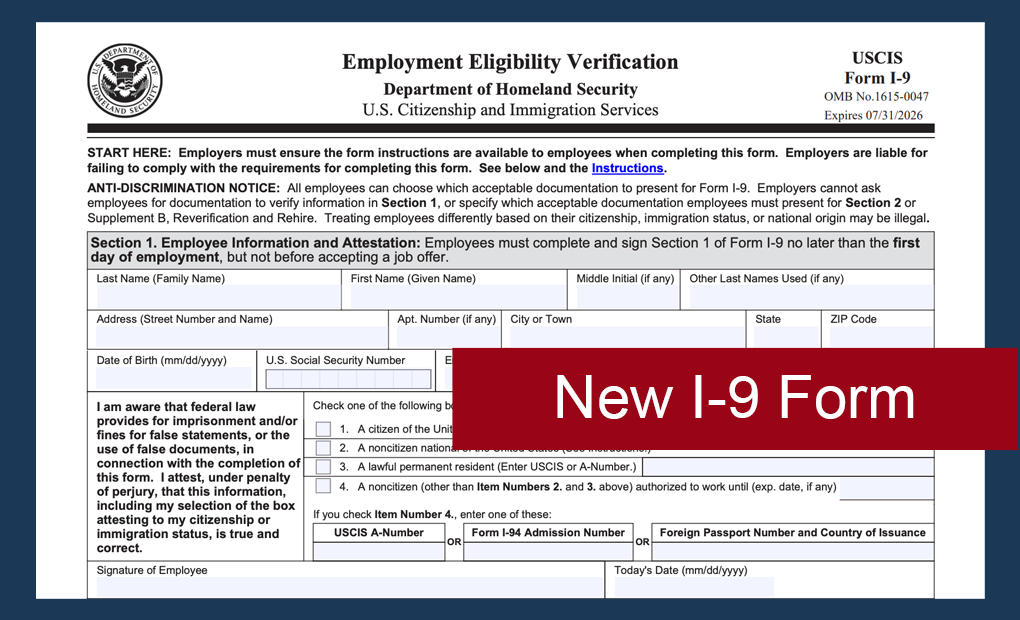Ph: 404.844.4130
Fax: 404.844.4135
3212 Northlake Pkwy #450906
Atlanta, GA 31145

Federal immigration officials just made critical changes to modernize the I-9 employment verification process. The Department of Homeland Security (DHS) announced on July 21 that the long-awaited new Form I-9 will be available for employers to use on August 1, 2023. Not only did they publish a new I-9 Form, but they are also providing remote verification flexibility for qualified employers that use E-Verify.
DHS Has Streamlined the Form I-9
Employers should be on the lookout for the new Form I-9 in the next week and can begin using it on August 1. YOU MUST USE THE NEW FORM BY NOVEMBER 1, 2023. Highlights of DHS’s changes to the form include:
DHS also reduced the length of the Form I-9 Instructions from 15 pages to eight pages.
Qualified E-Verify Employers May Examine Form I-9 Documents Remotely
Currently employers are required to physically examine an employee’s original identity and work authorization documents required by the I-9 procedures, which has created compliance challenges for many employers with remote hires. To remedy this problem, DHS is allowing the agency Secretary to authorize alternative document examination procedures as an optional alternative to the in-person physical document examination method. The first alternative DHS has authorized is an option for qualified E-Verify employers to remotely examine identity and work authorization documents beginning on August 1.
Qualified E-Verify employers are those employers who are in good standing with E-Verify, have enrolled in E-Verify with respect to all hiring sites that use the alternative procedure, and comply with all E-Verify requirements. If a qualified employer chooses to offer the alternative procedure to new employees at an E-Verify hiring site, it must do so consistently for all employees at that site. An employer may choose to offer the alternative procedure for remote hires only and continue to apply physical examination procedures to all employees who work onsite or in a hybrid capacity, so long as such a practice is not established for a discriminatory purpose. Of course, a qualified E-Verify employer may continue to examine documents physically instead of remotely. Additionally, you must allow employees who are unable or unwilling to submit documentation using the alternative procedure to submit documentation for physical examination.
Requirements of the Alternative Document Review Procedure
DHS Provides Relief for Some Employers Enrolled in E-Verify During COVID-19
Perhaps the most significant development is the alternative solution DHS is offering qualified employers who were left with an arduous task of bringing in all the employees they hired remotely during the COVID-19 pandemic to review their original documents and annotate their I-9s by the upcoming August 30 deadline. Qualified E-Verify employers can use the alternative procedure to satisfy the required physical examination of an employee’s documents for that Form I-9 if you:
Such employers should not create a new case in E-Verify. All qualified employers that use the alternative procedure instead of physical examination as described above must follow the steps of the alternative procedure and add “alternative procedure” with the date of examination (meaning the date the employer performed a live video interaction as required under the alternative procedure) to the Section 2 Additional Information field on the Form I-9 or in Section 3, as appropriate.
Employers who were not enrolled in E-Verify during the COVID-19 flexibilities must still complete an in-person physical examination by August 30.
Suggested Best Practices for Employers to Maximize Compliance
Even with the new improvements, the Form I-9 remains deceptively simple. Here are some steps you can take to facilitate compliance throughout your organization:
If you have questions or need assistance with non-solicitation issues, please contact one of our attorneys at Schwartz Rollins, or our legal assistant, Vicki Perry at 404.844.4130.
